
|   |

|   |
Samrachana Festival of Dance Choreography Photos courtesy: Odisha Tourism March 11, 2013 The second edition of Samrachana, the three day Festival of Dance Choreography was inaugurated on March 2, 2013 with great enthusiasm at Rabindra Mandap, Bhubaneswar. Organized jointly by Odisha Sangeet Natak Akademi and GKCM Odissi Research Centre under the aegis of Department of Tourism and Culture, Government of Odisha, this festival showcases choreographies based on different styles of classical dance by eminent choreographers. The inaugural evening started with the choreographic productions of Kiran Segal, which were based on the poems of Rabindranath Tagore. Other than traditional Odissi music, the use of Jazz and other instruments with beautiful synchronization and innovative costumes added beauty to the choreography. Patriotism was well reflected by the famous poem Ekla Chalo Re which speaks about the unity and bravery of our land. The costumes also had a tinge of Seraikella Chhau with use of face mask. Celebrating the rainy season through poem was another item with the traditional white and red bordered saree. The concluding item ‘Taalaangiya’ based on rhythm of different instruments was originally composed for the closing ceremony of India’s 50 years of Independence in 1997. 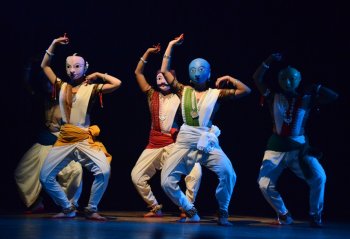 Kiran Segal’s group  Chitra Visweswaran’s group The second program of the evening was Bharatanatyam group choreography by eminent dancer Chitra Visweswaran and her group Chidambaram Dance Company from Chennai. The first item was based on the creator (Brahma), preserver (Vishnu) and the destroyer (Maheswara) which started on a fast pace. Creation of cosmic energy through the 5 elements reflected the internal energy within us. River Ganga known as the most revered river in our country was a splendid item. ‘Freedom of Soul, freedom of India’ was well described and the last item finished with the attainment of salvation. Beautiful costume and footwork enthralled the audience. The second day showcased Mohiniattam and Odissi, two very lyrical dance forms with all its intricacies and graceful movements. The program started with an invocatory piece on Lord Ganesha by Deepti Omchery Bhalla and her group Trikalaa Gurukula, New Delhi, entitled ‘Sabdachali’ depicting Brahma, Vishnu and Maheswara, the three inseparable deities who manifest creation, preservation and destruction of this world. This was followed by ‘Sivachaali’ in which the Lord of Dance dances to rhythm of mridangam, venu and veena. Tumburu and Narada sing with joy as they watch him dancing the tandava. 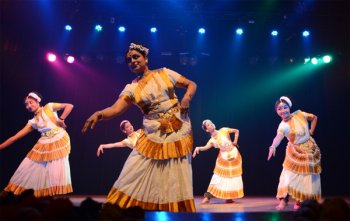 Deepti Omchery Bhalla’s group 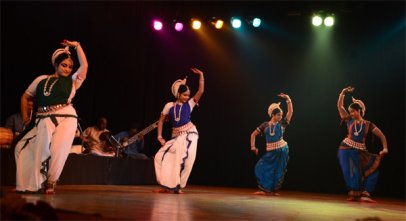 Kumkum Mohanty’s group The second program of the evening was presented by renowned Odissi exponent Kumkum Mohanty and her disciples of Gita Govinda, an institution founded by her. Their first presentation was Narayani Pallavi set to tala ektali. Beautifully presented justifying the meaningful composition, this was followed by her choreographic production ‘Bibarna Chaturanga’ in which she depicted the four stages of life with evolution of different sequences at different times mingled with the perplexities and complicated patterns of life. The production encompassed the playful pastime activities by children in the villages of Odisha and in the process depicted the manifestation of nature in different seasons. The realities in life had a true representation in this production. The music composed by eminent musician Prafulla Kar was based on a typical Odia tune. The final evening showcased Odissi and Kathak styles. The first program of the evening was Odissi by Jhelum Paranjape and her Smitalay troupe, Mumbai. They started with a dance offering to Lord Shiva, taken from the writings of Rabindranath Tagore. The dance began with the power of both male and female dancers with the traditional dance of Odissi Mangalacharana. The next item was about the cosmic energy within us which was followed by an inspirational dance piece talking about strength in life to overcome all hurdles and having faith in God. Likewise, life is compared to a boat and god to the boatman who takes us through the journey of life. Their final presentation was about moving on in life no matter what happens. 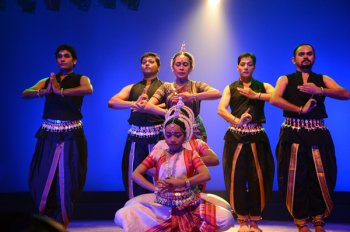 Jhelum Paranjape’s group 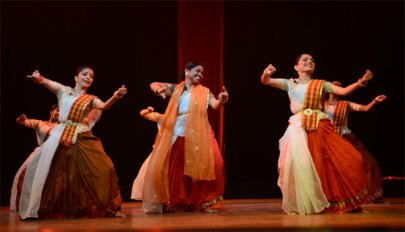 Rajashree Shirke’s group The second presentation of the concluding day was Kathak by Rajashree Shirke and group from Mumbai, with their special version of Ranga Nritya, dance with storytelling technique. The choreography was a blend of Indian theatre and Indian classical dance. The theme taken from Mahabharata, the dance was choreographed on Mata Hidimba and her son Ghatotkach. It showcased the difficulties faced by single motherhood in our present society. Being a democratic country, there is still disrespect towards women. The dance talks about the pangs of loss of a mother on the death of her son and Shirke and her group gave a brilliant portrayal through dance, verse, dialogues and histrionics. |